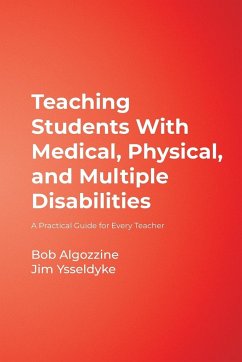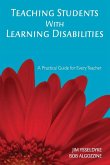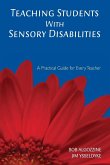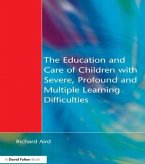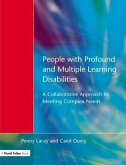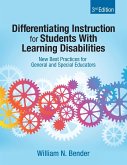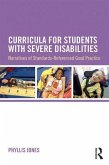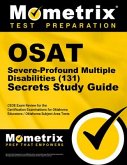Bob Algozzine, Jim Ysseldyke
Teaching Students With Medical, Physical, and Multiple Disabilities
A Practical Guide for Every Teacher
Bob Algozzine, Jim Ysseldyke
Teaching Students With Medical, Physical, and Multiple Disabilities
A Practical Guide for Every Teacher
- Broschiertes Buch
- Merkliste
- Auf die Merkliste
- Bewerten Bewerten
- Teilen
- Produkt teilen
- Produkterinnerung
- Produkterinnerung
Learn about assistive technologies, helpful adjustments to school and classroom environments, and effective instructional modifications specifically designed to support students with medical, physical, and multiple disabilities.
Andere Kunden interessierten sich auch für
![Teaching Students With Learning Disabilities Teaching Students With Learning Disabilities]() Jim YsseldykeTeaching Students With Learning Disabilities28,99 €
Jim YsseldykeTeaching Students With Learning Disabilities28,99 €![Teaching Students with Sensory Disabilities Teaching Students with Sensory Disabilities]() Bob AlgozzineTeaching Students with Sensory Disabilities28,99 €
Bob AlgozzineTeaching Students with Sensory Disabilities28,99 €![The Education and Care of Children with Severe, Profound and Multiple Learning Disabilities The Education and Care of Children with Severe, Profound and Multiple Learning Disabilities]() Richard AirdThe Education and Care of Children with Severe, Profound and Multiple Learning Disabilities58,99 €
Richard AirdThe Education and Care of Children with Severe, Profound and Multiple Learning Disabilities58,99 €![People with Profound & Multiple Learning Disabilities People with Profound & Multiple Learning Disabilities]() Penny LaceyPeople with Profound & Multiple Learning Disabilities66,99 €
Penny LaceyPeople with Profound & Multiple Learning Disabilities66,99 €![Differentiating Instruction for Students With Learning Disabilities Differentiating Instruction for Students With Learning Disabilities]() William N. BenderDifferentiating Instruction for Students With Learning Disabilities44,99 €
William N. BenderDifferentiating Instruction for Students With Learning Disabilities44,99 €![Curricula for Students with Severe Disabilities Curricula for Students with Severe Disabilities]() Phyllis JonesCurricula for Students with Severe Disabilities51,99 €
Phyllis JonesCurricula for Students with Severe Disabilities51,99 €![OSAT Severe-Profound/Multiple Disabilities (131) Secrets Study Guide OSAT Severe-Profound/Multiple Disabilities (131) Secrets Study Guide]() OSAT Severe-Profound/Multiple Disabilities (131) Secrets Study Guide64,99 €
OSAT Severe-Profound/Multiple Disabilities (131) Secrets Study Guide64,99 €-
-
-
Learn about assistive technologies, helpful adjustments to school and classroom environments, and effective instructional modifications specifically designed to support students with medical, physical, and multiple disabilities.
Hinweis: Dieser Artikel kann nur an eine deutsche Lieferadresse ausgeliefert werden.
Hinweis: Dieser Artikel kann nur an eine deutsche Lieferadresse ausgeliefert werden.
Produktdetails
- Produktdetails
- Verlag: Corwin
- Seitenzahl: 136
- Erscheinungstermin: 23. März 2006
- Englisch
- Abmessung: 229mm x 152mm x 8mm
- Gewicht: 209g
- ISBN-13: 9781412939010
- ISBN-10: 1412939011
- Artikelnr.: 22222005
- Herstellerkennzeichnung
- Books on Demand GmbH
- In de Tarpen 42
- 22848 Norderstedt
- info@bod.de
- 040 53433511
- Verlag: Corwin
- Seitenzahl: 136
- Erscheinungstermin: 23. März 2006
- Englisch
- Abmessung: 229mm x 152mm x 8mm
- Gewicht: 209g
- ISBN-13: 9781412939010
- ISBN-10: 1412939011
- Artikelnr.: 22222005
- Herstellerkennzeichnung
- Books on Demand GmbH
- In de Tarpen 42
- 22848 Norderstedt
- info@bod.de
- 040 53433511
Bob Algozzine is a professor in the Department of Educational Leadership at the University of North Carolina and project codirector of the U.S. Department of Education-supported Behavior and Reading Improvement Center. With 25 years of research experience and extensive firsthand knowledge of teaching students classified as seriously emotionally disturbed, Algozzine is a uniquely qualified staff developer, conference speaker, and teacher of behavior management and effective teaching courses. He is active in special education practice as a partner and collaborator with professionals in the Charlotte-Mecklenburg schools in North Carolina and as an editor of several journals focused on special education. Algozzine has written more than 250 manuscripts on special education topics, including many books and textbooks on how to manage emotional and social behavior problems.
About A Practical Approach to Special Education for Every Teacher
Acknowledgements
About the Authors
Self-Assessment I
Introduction to Teaching Students With Medical, Physical, and Multiple
Disabilities
1.What Are Medical Disabilities?
Identification of Medical Symptoms
Prevalence of Medical Disabilities
"Other" Health Impairments
Special Health Problems
Medically Fragile and Technology Dependent Groups
2.What Are Physical Disabilities?
Orthopedic Impairments
Specific Impairments
Neurological Disorders
Traumatic Brain Injury
Autism
3.What Are Multiple Disabilities?
4.What Characteristics Are Associated With Medical, Physical, and Multiple
Disabilities?
Cognitive
Academic
Physical
Behavioral
Communication
5. What Should Every Teacher Know About Teaching Students With Medical,
Physical, and Multiple Disabilities?
Identifying Disabilities
Asking Questions
Identifying Key Areas of Assistance
Adapting Instruction
Facilitating Communication
Fostering Independence
6.Medical, Physical, and Multiple Disabilities in Perspective
Selecting Home vs. Institutional Care
Supporting Inclusion
7. What Have We Learned?
Key Points
Key Vocabulary
Self-Assessment II
Answer Key for Self-Assessments
On Your Own
Resources
Books
Journals & Articles
Organizations
Reference
Index
Acknowledgements
About the Authors
Self-Assessment I
Introduction to Teaching Students With Medical, Physical, and Multiple
Disabilities
1.What Are Medical Disabilities?
Identification of Medical Symptoms
Prevalence of Medical Disabilities
"Other" Health Impairments
Special Health Problems
Medically Fragile and Technology Dependent Groups
2.What Are Physical Disabilities?
Orthopedic Impairments
Specific Impairments
Neurological Disorders
Traumatic Brain Injury
Autism
3.What Are Multiple Disabilities?
4.What Characteristics Are Associated With Medical, Physical, and Multiple
Disabilities?
Cognitive
Academic
Physical
Behavioral
Communication
5. What Should Every Teacher Know About Teaching Students With Medical,
Physical, and Multiple Disabilities?
Identifying Disabilities
Asking Questions
Identifying Key Areas of Assistance
Adapting Instruction
Facilitating Communication
Fostering Independence
6.Medical, Physical, and Multiple Disabilities in Perspective
Selecting Home vs. Institutional Care
Supporting Inclusion
7. What Have We Learned?
Key Points
Key Vocabulary
Self-Assessment II
Answer Key for Self-Assessments
On Your Own
Resources
Books
Journals & Articles
Organizations
Reference
Index
About A Practical Approach to Special Education for Every Teacher
Acknowledgements
About the Authors
Self-Assessment I
Introduction to Teaching Students With Medical, Physical, and Multiple
Disabilities
1.What Are Medical Disabilities?
Identification of Medical Symptoms
Prevalence of Medical Disabilities
"Other" Health Impairments
Special Health Problems
Medically Fragile and Technology Dependent Groups
2.What Are Physical Disabilities?
Orthopedic Impairments
Specific Impairments
Neurological Disorders
Traumatic Brain Injury
Autism
3.What Are Multiple Disabilities?
4.What Characteristics Are Associated With Medical, Physical, and Multiple
Disabilities?
Cognitive
Academic
Physical
Behavioral
Communication
5. What Should Every Teacher Know About Teaching Students With Medical,
Physical, and Multiple Disabilities?
Identifying Disabilities
Asking Questions
Identifying Key Areas of Assistance
Adapting Instruction
Facilitating Communication
Fostering Independence
6.Medical, Physical, and Multiple Disabilities in Perspective
Selecting Home vs. Institutional Care
Supporting Inclusion
7. What Have We Learned?
Key Points
Key Vocabulary
Self-Assessment II
Answer Key for Self-Assessments
On Your Own
Resources
Books
Journals & Articles
Organizations
Reference
Index
Acknowledgements
About the Authors
Self-Assessment I
Introduction to Teaching Students With Medical, Physical, and Multiple
Disabilities
1.What Are Medical Disabilities?
Identification of Medical Symptoms
Prevalence of Medical Disabilities
"Other" Health Impairments
Special Health Problems
Medically Fragile and Technology Dependent Groups
2.What Are Physical Disabilities?
Orthopedic Impairments
Specific Impairments
Neurological Disorders
Traumatic Brain Injury
Autism
3.What Are Multiple Disabilities?
4.What Characteristics Are Associated With Medical, Physical, and Multiple
Disabilities?
Cognitive
Academic
Physical
Behavioral
Communication
5. What Should Every Teacher Know About Teaching Students With Medical,
Physical, and Multiple Disabilities?
Identifying Disabilities
Asking Questions
Identifying Key Areas of Assistance
Adapting Instruction
Facilitating Communication
Fostering Independence
6.Medical, Physical, and Multiple Disabilities in Perspective
Selecting Home vs. Institutional Care
Supporting Inclusion
7. What Have We Learned?
Key Points
Key Vocabulary
Self-Assessment II
Answer Key for Self-Assessments
On Your Own
Resources
Books
Journals & Articles
Organizations
Reference
Index

